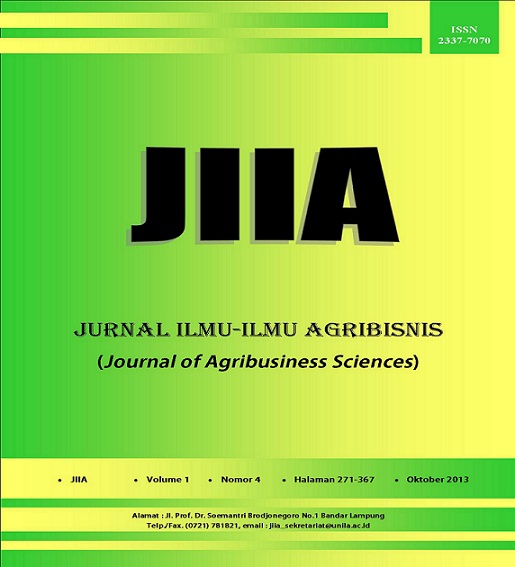KETAHANAN PANGAN RUMAH TANGGA PETANI JAGUNG DI KECAMATAN SIMPANG KABUPATEN OGAN KOMERING ULU (OKU) SELATAN
DOI:
https://doi.org/10.23960/jiia.v1i4.706 Abstract View: 916
Abstract View: 916
Abstract
The purpose of this research are to analyze the income of corn farming, household (HH) food security, and factors that affect HH food security in Simpang Subdistrict, South Ogan Komering Ulu (OKU) Regency. This research uses a survey method, with the samples of 60 corn farmer HHs from two villages that have less than 1 hectare of land. Food security (FS) is measured by the share of food expenditure (SFE) and availability in addition to food sufficiency level. The calculation of the HH expenditure is based onmonthly period, while food sufficiency level used the indicators of energy and protein sufficiency , measured byusing a recall method. The results of the research showed that the average of corn farming income was Rp7.937.429,11 in first seasonand Rp3.743.929,11 in second season, HH income was Rp5.085.500,24 per month. Based on the SFE there were 50 HHs having the number of SFEless than 60% (food secured). Based on the sufficiency of food energy and protein, there were 15 HHs (25%) categorized as enough to excess energy sources and 29 HHs (48,33%) categorized as enough to excess protein sources. The results of cross-classification between SFE and the energy sufficiency showed that there were 11 HHs infood secured, 39 HHs in food-less secured, 3 HHsfood vulnerableand 7 HHsfood-insecured catergory. Factors affecting the adequacy level of energy and protein of the household farmers were family size and food expenditure.
Key words: adequacy of energy and protein, food security, share of food expenditure
Downloads
Downloads
Published
How to Cite
Issue
Section
License
Authors who publish with this journal agree to the following terms:
Authors retain copyright and grant the journal right of first publication with the work simultaneously licensed under a Creative Commons Attribution License that allows others to share the work with an acknowledgement of the work's authorship and initial publication in this journal.
Authors are able to enter into separate, additional contractual arrangements for the non-exclusive distribution of the journal's published version of the work (e.g., post it to an institutional repository or publish it in a book), with an acknowledgement of its initial publication in this journal.
Authors are permitted and encouraged to post their work online (e.g., in institutional repositories or on their website) prior to and during the submission process, as it can lead to productive exchanges, as well as earlier and greater citation of published work (See The Effect of Open Access).














